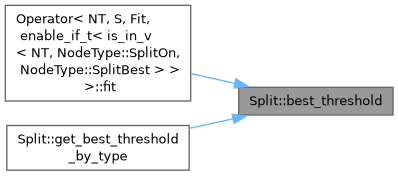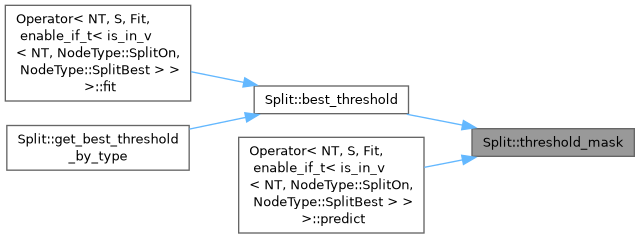Loading...
Searching...
No Matches
Split Namespace Reference
Functions | |
| template<typename T> | |
| ArrayXb | threshold_mask (const T &x, const float &threshold) |
| Applies a learned threshold to a feature, returning a mask. | |
| template<typename T> requires same_as<typename T::Scalar, bool> | |
| ArrayXb | threshold_mask (const T &x, const float &threshold) |
| Applies a learned threshold to a feature, returning a mask. | |
| template<typename T> requires same_as<typename T::Scalar, bJet> | |
| ArrayXb | threshold_mask (const T &x, const float &threshold) |
| Applies a learned threshold to a feature, returning a mask. | |
| template<typename T> requires same_as<typename T::Scalar, float> | |
| ArrayXb | threshold_mask (const T &x, const float &threshold) |
| Applies a learned threshold to a feature, returning a mask. | |
| template<typename T> requires same_as<typename T::Scalar, fJet> | |
| ArrayXb | threshold_mask (const T &x, const float &threshold) |
| Applies a learned threshold to a feature, returning a mask. | |
| template<typename T> requires same_as<typename T::Scalar, int> | |
| ArrayXb | threshold_mask (const T &x, const float &threshold) |
| Applies a learned threshold to a feature, returning a mask. | |
| template<typename T> requires same_as<typename T::Scalar, iJet> | |
| ArrayXb | threshold_mask (const T &x, const float &threshold) |
| Applies a learned threshold to a feature, returning a mask. | |
| float | gini_impurity_index (const ArrayXf &classes, const vector< float > &uc) |
| float | gain (const ArrayXf &lsplit, const ArrayXf &rsplit, bool classification, vector< float > unique_classes) |
| template<typename T> | |
| vector< float > | get_thresholds (const T &x) |
| tuple< string, float > | get_best_variable_and_threshold (const Dataset &d, TreeNode &tn) |
| template<typename T> | |
| tuple< float, float > | best_threshold (const T &x, const ArrayXf &y, bool classification) |
| template<typename T> | |
| void | get_best_threshold_by_type (const Dataset &d, auto &results) |
| template<typename Ts, std::size_t... Is> | |
| auto | get_best_thresholds (const Dataset &d, std::index_sequence< Is... >) |
| template<typename T> | |
| T | stitch (array< T, 2 > &child_outputs, const ArrayXb &mask) |
| Stitches together outputs from left or right child based on threshold. | |
Function Documentation
◆ best_threshold()
template<typename T>
| tuple< float, float > Split::best_threshold | ( | const T & | x, |
| const ArrayXf & | y, | ||
| bool | classification ) |
◆ gain()
| float Split::gain | ( | const ArrayXf & | lsplit, |
| const ArrayXf & | rsplit, | ||
| bool | classification, | ||
| vector< float > | unique_classes ) |
Here is the caller graph for this function:

◆ get_best_threshold_by_type()
template<typename T>
| void Split::get_best_threshold_by_type | ( | const Dataset & | d, |
| auto & | results ) |
◆ get_best_thresholds()
template<typename Ts, std::size_t... Is>
| auto Split::get_best_thresholds | ( | const Dataset & | d, |
| std::index_sequence< Is... > | ) |
◆ get_best_variable_and_threshold()
Here is the caller graph for this function:

◆ get_thresholds()
template<typename T>
| vector< float > Split::get_thresholds | ( | const T & | x | ) |
Here is the caller graph for this function:

◆ gini_impurity_index()
| float Split::gini_impurity_index | ( | const ArrayXf & | classes, |
| const vector< float > & | uc ) |
◆ stitch()
◆ threshold_mask() [1/7]
template<typename T>
| ArrayXb Split::threshold_mask | ( | const T & | x, |
| const float & | threshold ) |
◆ threshold_mask() [2/7]
template<typename T>
requires same_as<typename T::Scalar, bool>
requires same_as<typename T::Scalar, bool>
| ArrayXb Split::threshold_mask | ( | const T & | x, |
| const float & | threshold ) |
◆ threshold_mask() [3/7]
template<typename T>
requires same_as<typename T::Scalar, bJet>
requires same_as<typename T::Scalar, bJet>
| ArrayXb Split::threshold_mask | ( | const T & | x, |
| const float & | threshold ) |
◆ threshold_mask() [4/7]
template<typename T>
requires same_as<typename T::Scalar, float>
requires same_as<typename T::Scalar, float>
| ArrayXb Split::threshold_mask | ( | const T & | x, |
| const float & | threshold ) |
◆ threshold_mask() [5/7]
template<typename T>
requires same_as<typename T::Scalar, fJet>
requires same_as<typename T::Scalar, fJet>
| ArrayXb Split::threshold_mask | ( | const T & | x, |
| const float & | threshold ) |
◆ threshold_mask() [6/7]
template<typename T>
requires same_as<typename T::Scalar, int>
requires same_as<typename T::Scalar, int>
| ArrayXb Split::threshold_mask | ( | const T & | x, |
| const float & | threshold ) |







